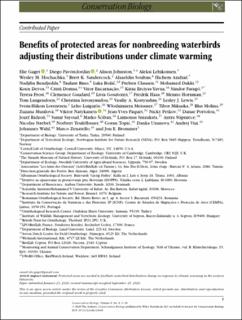Benefits of protected areas for nonbreeding waterbirds adjusting their distributions under climate warming
| dc.contributor.author | Gaget, Elie | |
| dc.contributor.author | Pavòn-Jordàn, Diego | |
| dc.contributor.author | Johnston, Alison | |
| dc.contributor.author | Lehikoinen, Aleksi | |
| dc.contributor.author | Hochachka, Wesley M. | |
| dc.contributor.author | Sandercock, Brett | |
| dc.contributor.author | Soultan, Alaaeldin | |
| dc.contributor.author | Azafzaf, Hichem | |
| dc.contributor.author | Bendjedda, Nadjiba | |
| dc.contributor.author | Bino, Taulant | |
| dc.contributor.author | Božič, Luka | |
| dc.contributor.author | Clausen, Preben | |
| dc.contributor.author | Dakki, Mohamed | |
| dc.contributor.author | Devos, Koen | |
| dc.contributor.author | Domsa, Cristi | |
| dc.contributor.author | Encarnaçao, Vitor | |
| dc.contributor.author | Erciyas-Yavuz, Kiraz | |
| dc.contributor.author | Faragó, Sándor | |
| dc.contributor.author | Frost, Teresa | |
| dc.contributor.author | Gaudard, Clemence | |
| dc.contributor.author | Gosztonyi, Lívia | |
| dc.contributor.author | Haas, Fredrik | |
| dc.contributor.author | Hornman, Menno | |
| dc.contributor.author | Langendoen, Tom | |
| dc.contributor.author | Ieronymidou, Christina | |
| dc.contributor.author | Kostyushin, Vasiliy A. | |
| dc.contributor.author | Lewis, Lesley J. | |
| dc.contributor.author | Lorentsen, Svein Håkon | |
| dc.contributor.author | Luiujoe, Leho | |
| dc.contributor.author | Meissner, Włodzimierz | |
| dc.contributor.author | Mikuska, Tibor | |
| dc.contributor.author | Molina, Blas | |
| dc.contributor.author | Musilova, Zuzana | |
| dc.contributor.author | Natykanets, Viktor | |
| dc.contributor.author | Paquet, Jean-Yves | |
| dc.contributor.author | Petkov, Nicky | |
| dc.contributor.author | Portolou, Danae | |
| dc.contributor.author | Ridzop, Jozef | |
| dc.contributor.author | Sayoud, Samir | |
| dc.contributor.author | Šdiban, Marko | |
| dc.contributor.author | Sniauksta, Laimonas | |
| dc.contributor.author | Stīpniece, Antra | |
| dc.contributor.author | Strebel, Nicolas | |
| dc.contributor.author | Teufelbauer, Norbert | |
| dc.contributor.author | Topid, Goran | |
| dc.contributor.author | Uzunova, Danka | |
| dc.contributor.author | Vizi, Andrej | |
| dc.contributor.author | Wahl, Johannes | |
| dc.contributor.author | Zenatello, Marco | |
| dc.contributor.author | Brommer, Jon E. | |
| dc.coverage.spatial | Western Palearctic | en_US |
| dc.date.accessioned | 2021-03-22T11:07:35Z | |
| dc.date.available | 2021-03-22T11:07:35Z | |
| dc.date.created | 2020-10-19T12:31:00Z | |
| dc.date.issued | 2020 | |
| dc.identifier.issn | 0888-8892 | |
| dc.identifier.uri | https://hdl.handle.net/11250/2734787 | |
| dc.description.abstract | Climate warming is driving changes in species distributions and community composition. Many species show a so-called climatic debt, where shifts in range have lagged behind faster shifts in temperature isoclines. Inside protected areas (PAs), community changes in response to climate warming can be facilitated by greater colonization rates by warm-dwelling species, but also mitigated by lowering extinction rates of cold-dwelling species. An evaluation of the relative importance of colonization-extinction processes is important to inform conservation strategies, aiming for both climate debt reduction and species conservation. Here, we assess the colonizationextinction dynamics involved in community changes in response to climate, inside and outside PAs, for changes in the occurrence of non-breeding waterbird species in the Western-Palearctic over 25years (97 species, 7,071 sites, 39 countries, 1993–2017). We used a community temperature index (CTI) framework based on species thermal affinities to investigate the species turn-over induced by temperature increase. In addition, we measured whether the thermal community adjustment was led by colonization by warm-dwelling species and/or extinction of cold-dwelling species, by modelling the change in standard deviation of the CTI (CTIsd). Using linear mixed-effects models, we investigated whether communities within PAs had lower climatic debt and different patterns of community change compared to unprotected sites. Combining the CTI and CTIsd, we found that communities inside PAs had more species, higher colonization, lower extinction and the climatic debt was 16% lower than of sites outside PAs. Thus, our results suggest the importance of PAs to facilitate two independent processes that shape community dynamics and maintain biodiversity. The community adjustment was however not sufficiently fast to keep pace with the strong temperature increase in central and northeastern Western-Palearctic regions. Our study underlines the potential of the combined CTI and CTIsd metrics to understand the colonization-extinction patterns driven by climate warming. colonization; community adjustment; community temperature index; extinction; range shift; wetlands | en_US |
| dc.language.iso | eng | en_US |
| dc.rights | Navngivelse 4.0 Internasjonal | * |
| dc.rights.uri | http://creativecommons.org/licenses/by/4.0/deed.no | * |
| dc.subject | colonization | en_US |
| dc.subject | community adjustment | en_US |
| dc.subject | community temperature index | en_US |
| dc.subject | extinction | en_US |
| dc.subject | range shift | en_US |
| dc.subject | wetlands | en_US |
| dc.title | Benefits of protected areas for nonbreeding waterbirds adjusting their distributions under climate warming | en_US |
| dc.type | Peer reviewed | en_US |
| dc.type | Journal article | en_US |
| dc.description.version | publishedVersion | en_US |
| dc.rights.holder | © 2020 The Authors. | en_US |
| dc.subject.nsi | VDP::Zoologiske og botaniske fag: 480 | en_US |
| dc.subject.nsi | VDP::Zoology and botany: 480 | en_US |
| dc.source.journal | Conservation Biology | en_US |
| dc.identifier.doi | 10.1111/cobi.13648 | |
| dc.identifier.cristin | 1840500 | |
| dc.relation.project | Norges forskningsråd: 295767 | en_US |
| cristin.ispublished | true | |
| cristin.fulltext | postprint | |
| cristin.qualitycode | 2 |
Tilhørende fil(er)
Denne innførselen finnes i følgende samling(er)
-
Publikasjoner fra CRIStin - NINA [2364]
-
Scientific publications [1392]
Vitenskapelige artikler, kapitler og monografier i Open Access.

